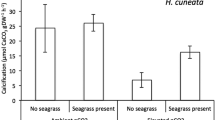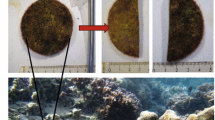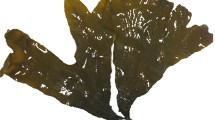Abstract
Rising seawater temperature and CO2 concentrations (ocean acidification) represent two of the most influential factors impacting marine ecosystems in the face of global climate change. In ecological climate change research, full-factorial experiments performed across seasons in multispecies, cross-trophic-level settings are essential as they permit a more realistic estimation of direct and indirect effects as well as the relative importance of the effects of both major environmental stressors on ecosystems. In benthic mesocosm experiments, we tested the responses of coastal Baltic Sea Fucus vesiculosus communities to elevated seawater temperature and CO2 concentrations across four seasons of one year. While increasing [CO2] levels had only minor effects, warming had strong and persistent effects on grazers, and the resulting effects on the Fucus community were found to be season dependent. In late summer, a temperature-driven collapse of grazers caused a cascading effect from the consumers to the foundation species, resulting in overgrowth of Fucus thalli by epiphytes. In fall/winter (outside the growing season of epiphytes), intensified grazing under warming resulted in a significant reduction in Fucus biomass. Thus, we were able to confirm the prediction that future increases in water temperatures will influence marine food-web processes by altering top-down control, but we were also able to show that specific consequences for food-web structure depend on the season. Since F. vesiculosus is the dominant habitat-forming brown algal system in the Baltic Sea, its potential decline under global warming implies a loss of key functions and services such as provision of nutrient storage, substrate, food, shelter, and nursery grounds for a diverse community of marine invertebrates and fish in Baltic Sea coastal waters.



Similar content being viewed by others
References
Alsterberg C, Eklöf JS, Gamfeldt L, Havenhand JN, Sundbäck K (2013) Consumers mediate the effects of experimental ocean acidification and warming on primary producers. Proc Natl Acad Sci USA 110:8603–8608
BACC Author Group (2008) Second assessment of climate change for the Baltic Sea Basin. Springer, Heidelberg
BACC Author Group (2015) Second assessment of climate change for the Baltic Sea Basin. Springer, Heidelberg
Borg Å, Pihl L, Wennhage H (1997) Habitat choice by juvenile cod (Gadus morhua L.) on sandy soit bottoms with different vegetation types. Helgol Meeresunters 51:197–212
Boyce DG, Frank KT, Leggett WC (2015) From mice to elephants: overturning the ‘one size fits all’ paradigm in marine plankton food chains. Ecol Lett 18:504–515
Brown JH, Gillooly JF, Allen AP, Savage VM, West GB (2004) Toward a metabolic theory of ecology. Ecology 85:1771–1789
Connell SD, Russell BD (2010) The direct effects of increasing CO2 and temperature on non-calcifying organisms: increasing the potential for phase shifts in kelp forests. Proc Biol Sci 277:1409–1415
Duarte CM, Chiscano CL (1999) Seagrass biomass and production: a reassessment. Aquat Bot 65:159–174
Eklöf JS, Alsterberg C, Havenhand JN, Sundbäck K, Wood HL, Gamfeldt L (2012) Experimental climate change weakens the insurance effect of biodiversity. Ecol Lett 15:864–872
Eklöf JS, Havenhand JN, Alsterberg C, Gamfeldt L (2015) Community-level effects of rapid experimental warming and consumer loss outweigh effects of rapid ocean acidification. Oikos 124:1040–1049
Elmgren R (1989) Man’s impact on the ecosystem of the Baltic Sea: energy flows today and at the turn of the century. Ambio 18:326–332
Engkvist R, Malm T, Tobiasson S (2000) Density dependent grazing effects of the isopod Idotea baltica Pallas on Fucus vesiculosus L in the Baltic Sea. Aquat Ecol 34:253–260
Goecker ME, Kåll SE (2003) Grazing preferences of marine isopods and amphipods on three prominent algal species of the Baltic Sea. J Sea Res 50:309–314
Grace JB (2006) Structural equation modeling and natural systems. Cambridge University Press, New York
Graiff A, Liesner D, Karsten U, Bartsch I (2015) Temperature tolerance of western Baltic Sea Fucus vesiculosus—growth, photosynthesis and survival. J Exp Mar Biol Ecol 471:8–16
Hansen T, Gardeler B, Matthiessen B (2013) Technical note: precise quantitative measurements of total dissolved inorganic carbon from small amounts of seawater using a gas chromatographic system. Biogeosciences 10:6601–6608
HELCOM (2013) HELCOM Red List of Baltic Sea species in danger of becoming extinct. Baltic Sea environment proceedings no. 140. Baltic Marine Environment Protection Commission, Helsinki
HELCOM (2014) Eutrophication status of the Baltic Sea 2007–2011—a concise thematic assessment. Baltic Sea environment proceedings no. 143. Baltic Marine Environment Protection Commission, Helsinki
Hillebrand H (2009) Meta-analysis of grazer control of periphyton biomass across aquatic ecosystems. J Phycol 45:798–806
Hillebrand H, Durselen CD, Kirschtel D, Pollingher U, Zohary T (1999) Biovolume calculation for pelagic and benthic microalgae. J Phycol 35:403–424
Hillebrand H, Borer ET, Bracken MES, Cardinale BJ, Cebrian J, Cleland JJE, Gruner DS, Harpole WS, Ngai JT, Sandin S, Seabloom EW, Shurin JB, Smith JE, Smith MD (2009) Herbivore metabolism and stoichiometry each constrain herbivory at different organizational scales across ecosystems. Ecol Lett 12:516–527
Holmlund MB, Peterson CH, Hay ME (1990) Does algal morphology affect amphipod susceptibility to fish predation. J Exp Mar Biol Ecol 139:65–83
Hughes AR, Stachowicz JJ (2009) Ecological impacts of genotypic diversity in the clonal seagrass Zostera marina. Ecology 90:1412–1419
IPCC (2014) Climate change 2014: impacts, adaptation, and vulnerability. Part A: Global and sectoral aspects. Contribution of Working Group II to the Fifth Assessment Report of the Intergovernmental Panel on Climate Change. Cambridge University Press, Cambridge
Jansson BO, Dahlberg K (1999) The environmental status of the Baltic Sea in the 1940’s, today, and in the future. Ambio 28:312–319
Johnson VR, Brownlee C, Rickaby REM, Graziano M, Milazzo M, Hall-Spencer JM (2013) Responses of marine benthic microalgae to elevated CO2. Mar Biol 160:1813–1824
Karez R, Engelbert S, Sommer U (2000) ‘Co-consumption’ and ‘protective coating’: two new proposed effects of epiphytes on their macroalgal hosts in mesograzer–epiphyte–host interactions. Mar Ecol Prog Ser 205:85–93
Kautsky H, Kautsky L, Kautsky N, Kautsky U, Lindblad C (1992) Studies on the Fucus vesiculosus community in the Baltic Sea. Acta Phytogeogr Suec 78:33–48
Kotta J, Orav-Kotta H, Paalme T, Kotta I, Kukk H (2006) Seasonal changes in situ grazing of the mesoherbivores Idotea baltica and Gammarus oceanicus on the brown algae Fucus vesiculosus and Pylaiella littoralis in the central Gulf of Finland, Baltic Sea. Hydrobiologia 554:117–125
Kraufvelin P, Ruuskanen A, Bäck S, Russell G (2012) Increased seawater temperature and light during early springs accelerate receptacle growth of Fucus vesiculosus in the northern Baltic proper. Mar Biol 159:1795–1807
Kroeker KJ, Kordas RL, Crim R, Hendriks IE, Ramajos L, Singh GS, Duarte CM, Gattuso JP (2013) Impacts of ocean acidification on marine organisms: quantifying sensitivities and interaction with warming. Glob Change Biol 19:1884–1896
Leidenberger S, Harding K, Jonsson PR (2012) Ecology and distribution of the isopod genus Idotea in the Baltic Sea: key species in a changing environment. J Crustac Biol 32:359–381
Lewandowska AM, Boyce DG, Hofmann M, Matthiessen B, Sommer U, Worm B (2014) Effects of sea surface warming on marine plankton. Ecol Lett 17:614–623
Little C, Kitching JA (1996) The biology of rocky shores. Oxford University Press, London
Lotze HK, Lenihan HS, Bourque BJ, Bradbury RH, Cooke RG, Kay MC, Kidwell SM, Kirby MX, Peterson CH, Jackson JBC (2006) Depletion, degradation, and recovery potential of estuaries and coastal seas. Science 312:1806–1809
Mann KH (1973) Seaweeds: their productivity and strategy for growth: the role of large marine algae in coastal productivity is far more important than has been suspected. Science 182:975–981
Menden-Deuer S, Lessard EJ (2000) Carbon to volume relationships for dinoflagellates, diatoms, and other protist plankton. Limnol Oceanogr 45:569–579
O’Connor MI, Piehler MF, Leech DM, Anton A, Bruno JF (2009) Warming and resource availability shift food web structure and metabolism. PLoS Biol 7:e1000178. doi:10.1371/journal.pbio
Pedersen MF, Borum J (1996) Nutrient control of algal growth in estuarine waters. Nutrient limitation and the importance of nitrogen requirements and nitrogen storage among phytoplankton and species of macroalgae. Mar Ecol Progr Ser 142:261–272
Persson A, Ljungberg P, Andersson M, Götzman E, Nilsson PA (2012) Foraging performance of juvenile Atlantic cod Gadus morhua and profitability of coastal habitats. Mar Ecol Progr Ser 456:245–253
Pierrot D, Lewis E, Wallace DWR (2006) MS Excel program developed for CO2 system calculations (report ORNL/CDIAC-105). Carbon Dioxide Information Analysis Center, Oak Ridge National Laboratory, Oak Ridge
Pihl L, Wennhage H, Nilsson S (1994) Fish assemblage structure in relation to macrophytes and filamentous epiphytes in shallow non-tidal rocky- and soft-bottom habitats. Environ Biol Fishes 39:271–288
Poore AGB, Campbell AH, Coleman RA, Edgar GJ, Jormalainen V, Reynolds PL, Sotka EE, Stachowicz JJ, Taylor RB, Vanderklift MA, Duffy JE (2012) Global patterns in the impact of marine herbivores on benthic primary producers. Ecol Lett 15:912–922
Raffaelli D, Hawkins S (1999) Intertidal ecology, 2nd edn. Kluwer, London
Reusch TBH, Ehlers A, Hammerli A, Worm B (2005) Ecosystem recovery after climatic extremes enhanced by genotypic diversity. Proc Natl Acad Sci USA 102:2826–2831
Sandjensen K, Borum J (1991) Interactions among phytoplankton, periphyton, and macroepiphytes in temperature fresh-waters and estuaries. Aquat Bot 41:137–175
Schernewski G, Hofstede J, Neumann T (2010) Global change and Baltic coastal zones. Coastal research library, vol 1. Springer, Dordrecht
Sommer U (2000) Benthic microalgal diversity enhanced by spatial heterogeneity of grazing. Oecologia 122:284–287
Sommer U, Lewandowska A (2011) Climate change and the phytoplankton spring bloom: warming and overwintering zooplankton have similar effects on phytoplankton. Glob Change Biol 17:154–162
Steneck RS, Watling L (1982) Feeding capabilities and limitation of herbivorous molluscs: a functional group approach. Mar Biol 68:299–319
Thomsen J, Gutowska MA, Saphörster J, Heinemann A, Trübenbach K, Fietzke J, Hiebenthal C, Eisenhauer A, Körtzinger A, Wahl M (2010) Calcifying invertebrates succeed in a naturally CO2-rich coastal habitat but are threatened by high levels of future acidification. Biogeosciences 7:3879–3891
Torn K, Krause-Jensen D, Martin G (2006) Present and past depth distribution of bladderwrack (Fucus vesiculosus) in the Baltic Sea. Aquat Bot 84:53–62
Utermöhl H (1958) Zur Vervollkommnung der quantitativen Phytoplankton-Methodik. Mitt Int Verein Limnol 9:1–38
Wahl M, Buchholz B, Winde V, Golomb D, Guy-Haim T, Müller J, Rilov G, Scotti M, Böttcher ME (2015) A mesocosm concept for the simulation of near-natural shallow underwater climates: the Kiel Outdoor Benthocosms (KOB). Limnol Oceanogr Methods. doi:10.1002/lom3.10055
Wallentinus I (1984) Comparison of nutrient-uptake rates for Baltic macroalgae with different thallus morphologies. Mar Biol 80:215–225
Wikström SA, Kautsky L (2007) Structure and diversity of invertebrate communities in the presence and absence of canopy-forming Fucus vesiculosus in the Baltic Sea. Estuar Coast Mar Sci 72:168–176
Worm B, Sommer U (2000) Rapid direct and indirect effects of a single nutrient pulse in a seaweed–epiphyte–grazer system. Mar Ecol Prog Ser 202:283–288
Worm B, Lotze HK, Sommer U (2000) Coastal food web structure, carbon storage, and nitrogen retention regulated by consumer pressure and nutrient loading. Limnol Oceanogr 45:339–349
Acknowledgments
This research was funded by the Federal Ministry of Education and Research (BMBF) in the framework of the project Biological Impacts of Ocean Acidification (BIOACID II, project 11/2.3). B. Buchholz, C. Eich, T. Hanssen, C. Meyer, B. Gardeler, and P. Schulz are gratefully acknowledged for their technical and laboratory support. We are grateful for valuable comments by B. K. Eriksson which improved a former version of this manuscript, and we sincerely thank the anonymous reviewers for their critiques and suggestions.
Author contribution statement
BM, FJW, and AG designed the study. FJW and AG performed the experiments and analyzed the data. BM provided funding and intellectual input into the analysis. FJW wrote the manuscript, with BM providing substantial contributions.
Author information
Authors and Affiliations
Corresponding author
Additional information
Communicated by Ulrich Sommer.
Electronic supplementary material
Below is the link to the electronic supplementary material.
Rights and permissions
About this article
Cite this article
Werner, F.J., Graiff, A. & Matthiessen, B. Temperature effects on seaweed-sustaining top-down control vary with season. Oecologia 180, 889–901 (2016). https://doi.org/10.1007/s00442-015-3489-x
Received:
Accepted:
Published:
Issue Date:
DOI: https://doi.org/10.1007/s00442-015-3489-x




